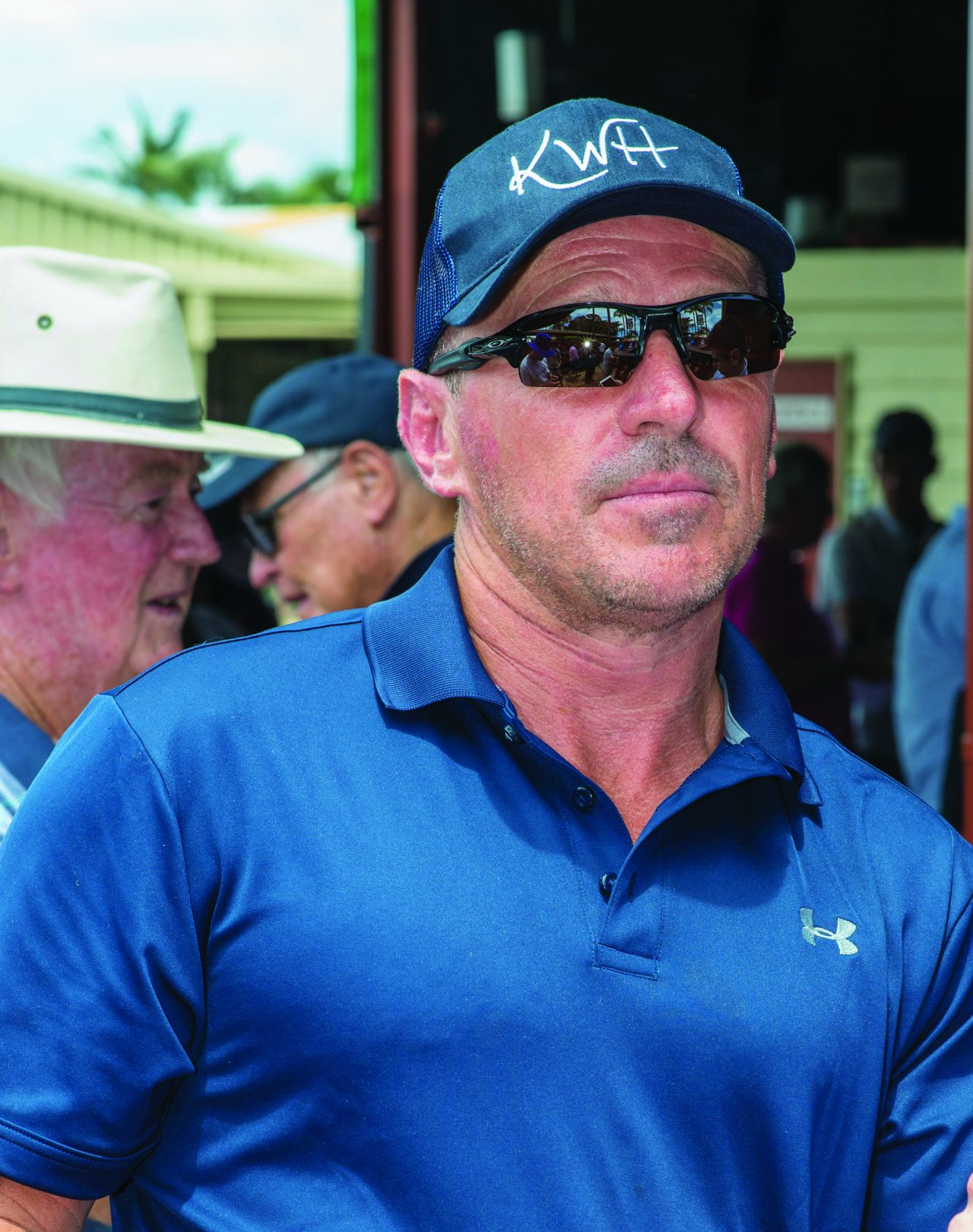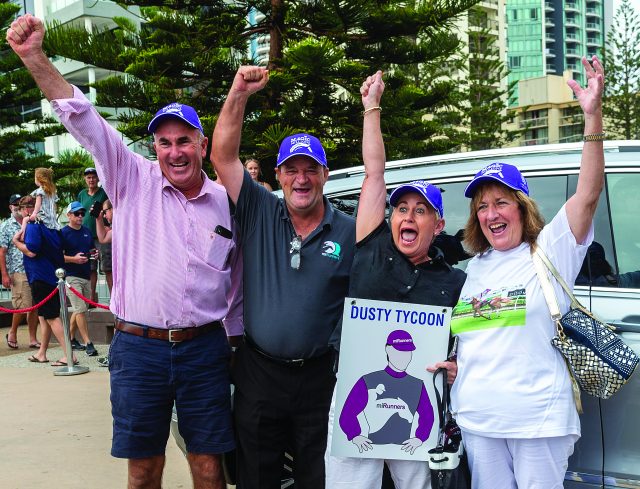[Published Bluebloods Nov/Dec 2020]

Since the reign of King Charles II and the acknowledged birth of modern racing circa 370 years ago, the number of truly innovative changes to our sport can, arguably, be counted on one hand. History will judge if micro-ownership will be added to that list and if it can, then MiRunners and co-founder Steve Brown will be lauded as having been at the forefront of a brave new era that has the potential to cure a number of the sport’s current ills.
Steve, where did your passion for horse racing begin?
Our grandfather was a reasonably large owner who introduced us to the races and the adrenaline charge that goes with racehorse ownership. Probably the best horse he raced was Opera Prince (Bletchingly) who had a victory over the great Manikato (Manihi) in the (Gr.2) Chirnside Stakes, now the Schillaci. That was a big moment for us as a family.
That’s a giant leap from where you are now. How did you get from there to today?
The financial markets were reasonably good to me I guess, which allowed me to gradually learn and develop my interests. Our parents had a cattle block at Scone, and together we converted that into horse country which was the start of Kitchwin Hills. Thereafter we bought a neighbouring property and developed that from scratch which evolved the farm to its current state. Last year Kitchwin Hills had bred an (The) Everest winner in Yes, Yes, Yes (Rubick) and a Melbourne Cup winner in Vow And Declare (Declaration Of War) amongst others like Gr.1 winners Pierata (Pierro) and Dreamforce (Fastnet Rock), which in one year shows the farm can punch pretty hard in terms of the horses that are coming off it compared to the size of the operation. We have a sense of something unique about this country, there was no science to the location of Kitchwin, let’s be honest, we got lucky to end up as the only stud in what is a special little limestone valley.
So, what was the path that took you from Kitchwin Hills to The Racing League?
The first step was the development of the MiStable business. We at Kitchwin Hills saw how much joy the owners got from strong communications and we were always trying to take our breeders from their offices into the paddocks. That original concept we developed into the MiStable software business. Once we had the communications platform for MiStable that was scaleable we started to formulate the idea of MiRunners.
We were always of the opinion that racing shouldn’t be an elite sport, particularly in a country like Australia, and that it should be accessible to everyone. It seemed to us crazy that as an industry we were ruling out 98% of the population, particularly on the trump card of the sport which is ownership. No other sport can compete with racing when it comes to owning the player. Given a background in financial markets and unitised offerings we thought there was an opportunity to do things differently and so five years ago we tested the market in ownership to see if that would work. The response was pretty overwhelming in regard to making the ownership of expensive horses more affordable. By unitising we were able to change the traditional 20 owner model to 1000 owners, or 50 times the historical standard. It proved popular and with 13,000 units sold, that is where MiRunners is today.
I understand the concept has had benefits you probably didn’t envisage through the planning process.
We get to hear stories of how this is changing people’s lives, like the recently widowed father who had virtually given up on life. Then his kids bought him a MiRunners share and now he is rejuvenated, studies the form and can’t wait to hear the communications from the trainer. That’s the sort of thing affordable ownership can bring to people. Ownership is an industry asset we want to unleash.
The micro-ownership concept has been tried globally previously but hasn’t worked. Why is it you think MiRunners has defied historic convention?
In my opinion the timing was right from a technology point of view. The communication aspect made it possible as did the rapidly advancing payments technology. As an organisation we were the first that enabled people to buy a racehorse on their mobile in 2 minutes with no paperwork. Buying ownership and making subscription payments via a phone is playing toward the tailwinds of technology. We also prioritised transparency. For a business to succeed we unquestionably needed to earn people’s trust and as many people know you can earn a lot of trust by telling the truth. It was what you saw, there was no mark-up on the horses that we bought, and the subscription fees were very transparent. MiRunners is very much a “what you see it was you pay business”.
Also, the $200-$300 price point helped, sometimes it can be less than that, and the cap of a maximum of twenty units per buyer didn’t cater for a bigger buyer which the smaller buyers found appealing.
I know anecdotally the idea was derided by many at the start. How did you respond to your detractors?
We quickly built up an army of supporters, and while you will always get your knockers with anything new, that army backed us up. When the knockers were out in force it was that army which shot their arguments down to the point where, in the end, we didn’t have to defend the concept, our thousands of owners were doing that for us. The vast majority of our owners are first time owners. We have seen many MiRunners owners graduate to other syndicators or trainers directly. We had one of our trainers sheepishly apologise as one of our owners had taken a stake in a horse he was offering. That was a fantastic example of micro ownership acting as an industry incubator, a nursery for the future. Nothing to apologise for, we love seeing that happen. It means we are doing a good job.
What regulatory hurdles did you face to get this over the line?
The financial hurdles were the biggest to overcome. These are ASIC (Australian Securities and Investments Commission) regulated and compliant schemes. All the sales funds go into a segregated Trust Account for the purchase of each horse while the subscription charges are used to run the business and pay all the ongoing costs. Being an ASIC Approved Scheme it’s not cheap to run in that regard, but Tony Fleiter of Sire Custodians ensures best practice and one of the reasons it has proven bullet proof so far is Tony’s vast experience and expertise in that area.
For a business still in its infancy you have had a few red-letter days already, please tell us about some.
We had the experience of having a runner in the Magic Million 2YO Classic this year in Dusty Tycoon (Written Tycoon) with 700 owners flying in from around Australia just to be on track on the day. We would have had more but 700 was the most we could fit in on course. They flew in from places like Broome, Perth, Tasmania and Victoria and had the time of their lives watching their 1/1000th of a share go around.
It’s around that time the industry started to take notice of what can be achieved with large scale ownership. There have been MiRunners horses running across the country and both Sky Racing and racing.com have commented that they have not heard an atmosphere like it on course when the MiRunners owners are in attendance.
Micro-ownership is a game changer. Having those owners on course converts to increased food and beverage sales and wagering for the track. One particular day wagering was up 15%, F&B was up 70% attributed singularly to the MiRunners owners being on course. Peter V’landys went on record at the most recent Asian Racing Conference stating he believes micro-ownership is the future of the sport.

Magic Millions day must have been a fantastic experience, but I take it you weren’t prepared to rest there?
The next step was to have a crack at The Everest and we bought Greg and Barb Ingham’s GPI Racing slot for $880,000 and divided it into 1000 shares at $880 each, again no mark-up. What we found was groups of people were buying a share, cricket teams, golfing mates, school groups and the like, so the final total of actual people involved came in at 2300. And they had one hell of a ride. We had selected Rothfire (Rothesay) who won the (Gr.2) Run To The Rose in course record time and was sent out the shortest priced favourite in the history of the (Gr.1) Golden Rose. There was a fairy tale story developing around Australia and of course it got torn up in front of people’s eyes when he broke down in the Golden Rose. There can be no better example of the highs and lows of racing than Rothfire.
As a group we then had to renegotiate and, given all the top liners were gone, we still thought we had the right horse in Eduardo (Host). As it turned out he didn’t run his race, having previously split Classique Legend (Not A Single Doubt) and Bivouac (Exceed And Excel) in (Gr.2) The Shorts. Although we as management were disappointed with the way things played out, all the feedback we have had from our owners was “it doesn’t matter, we’ve had the time of our lives”.
Following the success of MiRunners you have upped the ante with the exciting announcement of The Racing League. What does the new concept entail and what will it bring to the table?
All along we have been looking to scale the experience and the next step was The Racing League (TRL). TRL has been in a building phase for the last two years with the launch taking place in September this year. Owners can buy into six premium level horses for $200 a share making it extremely affordable and attractive, but importantly we think we are bringing a new aspect to ownership, tribalism.
There isn’t a global sport that isn’t driven by tribalism, other than racing. The four teams involved in Phase One, Queensland, New South Wales, Victoria and Western Australia bring that tribalism to the sport and we will look to expand teams over time. We see tribalism in the Big Bash, the English Premier League, the NBL and almost every other sport, but until now not racing. It is a long-term play, but we think it can be really impactful.
We will aim to purchase 24 horses and the owners will get to choose which six horses they want in their team in a draft style process. Those six horses will then race in the usual racing jurisdictions of the team. Using the WA Black Hearts as an example the six selected horses will be trained in Perth, but they will race where their ability best warrants them and at the level we will be buying at we would be hopeful some will make their way east.
How has the concept been greeted?
There has been huge engagement, people are signing up in their thousands and, although we’ve got a fair way to go, we are getting to the stage where we are ready to purchase the horses which should spur things on even further as things are about to get real for the owners of the four teams.
There are four celebrities as team captains, what are their roles?
The team captains Billy Slater, Shane Crawford, Laurie Daley and Brittany Taylor, who are all racing fanatics, will lead their teams, but each team has an individual manager from the industry. We thought that there were going to be some serious decisions made and guidance offered by the team manager for each team so for example we brought in people like Tye Angland who understands the industry and has a working relationship with trainers and jockeys as the Manager for New South Wales. Tye’s role will be to guide the owners in New South Wales through each decision.
It sounds like this is going to be very technology reliant.
Technology these days is pretty amazing, and the platform is there for owners to vote on a range of decisions. They’ll be asked to select which horses they want from the draft, then which name they prefer and which trainers they want. They have to sell one horse each year and trade one internally within TRL and they’ll be asked to vote on that so there will be some emotive decisions to be made along the way. They’ll also receive outstanding communications, and visualisations of the league ladder which will provide an awesome experience.
If the TRL becomes a successful as you hope do you think the possibility is there for it to change the traditional ways in which ownership is viewed?
I don’t think the industry quite has its head around the red flags that are facing racing at present. We’ve spoken to all the Principal Racing Authorities and the one constant is none of them are patting themselves on the back taking racing’s future for granted. Our concern with where racing is headed cites factors like declining attendance levels, even prior to COVID, the downturn in television audiences, that sports betting is eating into racing’s wagering pie and that the next generation is unfortunately totally disconnected from racing. That the twenty to thirty-year-old demographic doesn’t really care about racing any more is scary and racing together needs to do something about it. We are very fortunate to have fantastic prizemoney levels in Australia, the richest of any open jurisdiction in the world. We need to take advantage of this situation while we can and TRL and MiRunners help to provide this opportunity.
While there are sections of the industry that recognise these issues, I think there are people within the industry that don’t really get it. As an example, Rugby Union has become a second-tier sport overnight and racing risks the same fate if it doesn’t innovate and change. The financial platform for the industry is enormous, just look at how much is invested in the breeding industry alone, and to have a second-tier status in the future will mean there is a lot of pain for a lot of people. We would like to see everyone within the industry rally behind innovative projects that are aimed at countering those red flags. Change is happening globally at a rate never seen before with some industries being warned and wiped out almost simultaneously and we can’t take this wonderful sport for granted or it might just happen to racing.
That is sound advice for the industry at large, but what would you say to an individual entering the industry?
In racing one needs to be able to take the highs and the lows and have a high level of resilience. There are so many things that can go right and so many things that can go wrong, just expect the unexpected. Even just the challenges we have faced as a team around micro-ownership, without resilience levels bordering on madness, we wouldn’t be around today.



